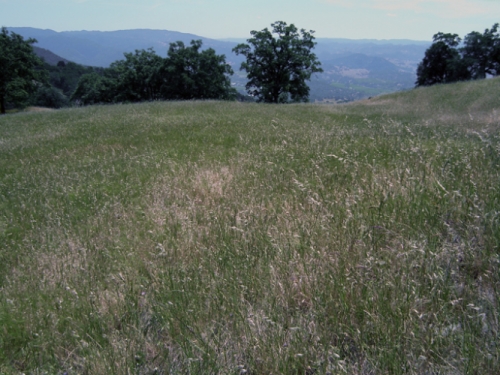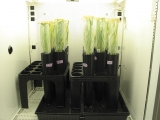In the past two hundred years, the green, bunchy grasses that once grew over eleven million acres of California grasslands have been usurped by carpets of invasive golden weeds. Only 1 percent of the native grasslands remain, and they now top the list of the most disturbed and endangered ecosystems in North America. This transformation has baffled scientists, and attempts to restore the grasslands have largely failed. Charles Mitchell, a disease ecologist, thinks a virus is to blame. If he’s right, he holds the key to restoring the California grasslands — and could help explain how both plant and human diseases transition from emerging threats to full-blown epidemics.
The devastating effects of more familiar epidemics are well known. Diseases such as bubonic plague, the Spanish Flu, Dutch elm disease, and the potato blight of the Great Famine all swept through populations and drastically altered ecosystems long after their initial outbreaks. But what conditions allowed these diseases to spread so well?
Scientists have identified a lot of variables that contribute to a disease’s success: transmission routes, duration of contagiousness, mortality rate. Epidemiologists have figured out mathematical models that take all of these factors into account, and have used them successfully in fighting the spread of endemic diseases such as HIV/AIDS and malaria. But these models don’t yet exist for emerging diseases such as avian flu and SARS.
The California grasses may change that.
Mitchell and his team of researchers are studying the spread of a virus called the barley yellow dwarf virus (BYDV) in California grasslands. They hope modeling BYDV will help us understand how diseases interact with their environments to become epidemics.
“We’re interested in understanding the causes of disease spread, and we can do manipulative experiments with plants that would be either unethical or just impossible with animals, let alone humans,” Mitchell says.
BYDV and the California grasslands make a great system for studying the spread of disease. “It’s a classic example of a major biological invasion,” he says.
Stowaway seeds
It started in the 1500s, when Spanish settlers arrived in California, bringing with them the seeds of Mediterranean grasses. The settlers may have planted some grass intentionally for grazing livestock, making medicines, or for ornamentation. Other seeds may have been brought accidentally as stowaways in ship ballast, hay, or crop seed. The golden annual grasses not only set up shop, but took over the place, spreading over more than 10 percent of the state of California. More than three hundred species of native, perennial green grasses were forced out of their habitats.
As the golden grasses spread, ecosystems lost the benefits of the native grasses, which have deep roots that stabilize the soil and filter pollutants. The native grasses also produce nutrient-rich material for foraging animals, and provide nests and harbors for native mammals and insects.
“Ecologists have long puzzled over why the invasion was so successful that there could be a wholesale replacement of a native flora by an exotic one,” Mitchell says.
At first researchers thought the success of the golden grasses was a case of classic competition — new species edging out old ones by monopolizing resources. But now researchers think that BYDV led to a situation ecologists call apparent competition — when one species acts as a food source for a predator, increasing the predator population and allowing it to reduce the numbers of a second species.
BYDV is the most widely spread virus of grasses, and causes significant damage to cereal crops such as wheat, oats, and, of course, barley. The virus spreads when an aphid punctures the stem of an infected plant to suck out sap, and then carries BYDV to an uninfected plant. Almost all grasses are susceptible to aphids and BYDV, but not all have the same rate of infection and severity of disease.
“Whenever you have transmission of a disease between a native and an introduced species, it raises the question of which species will transmit the disease more effectively and what are the relative impacts of the disease on the different species — which species will be on the winning end and which will be on the losing end?” Mitchell says. In California, the golden exotic grasses won and continue to win. But how’d they do it?
Researchers have to take more into account than just the disease. “The old frontier in disease ecology was predicting the dynamics of a single pathogen species infecting a single host species,” Mitchell says. This strategy has been useful in making mathematical models for the spread of pathogens such as HIV. “But most pathogens infect multiple host species — for example, over sixty percent of human pathogens also infect nonhuman animals — and host-pathogen interactions occur in complex environments,” he says.
To understand the apparent competition between exotic and native grasses, researchers have to understand the relative populations of each species, their rates of BYDV infection, the preferences of the aphids for feeding, and how changes in these factors feed back into the system. This is exactly what Mitchell is trying to do to understand how this disease — and others — spread.
Aggressive exotics
Mitchell hypothesizes that nutrient cycling and the way grasses grow are key factors for modeling diseases such as BYDV. The native, perennial grasses are slow-growing and conservative in their uptake and use of nutrients. The exotic annuals are fast-growing and quick to use resources from their environment. California grasslands are rich in nitrogen, and Mitchell speculates that this environment gives the fast-growing, exotic grasses an advantage.
Aphids grow and thrive on the booming exotic grasses. But because the exotics can quickly take up the nutrients available to them, they’re more tolerant of aphid attacks and viral infection. The slow-growing, conservative perennials are less tolerant and come in contact with the virus more often as neighboring exotics become aphid havens.
The exotic annuals die out each year, which gives them the opportunity to clear the virus from their population. Some of the native perennials, such as purple needlegrass, may live as long as a thousand years, carrying the virus far longer than the exotics do.
So far this is Mitchell’s hypothesis. He and his team are trying to pinpoint quantifiable traits that they can use to establish a model for BYDV.
First they must measure specific traits and physical features of the grasses. How fast do they perform photosynthesis? How long do they live? What are the concentrations of nutrients in their leaves? How tough and dense are their leaves? Then the team will see if the data they collect can predict disease trends. “We have the general idea,” Mitchell says, “but we’re still a step away from having a concrete, robust model of how those epidemiological traits predict disease dynamics in a community.”
So they’ve set up experiments to start taking measurements in the greenhouse and at field sites. By nailing down the traits that explain the community changes and disease spread, they hope to create a model that can be applied to other community changes and diseases.
Trait measurements such as photosynthetic capacity and leaf toughness might not seem like useful data for countering human infectious diseases, but Mitchell’s research addresses the most serious challenges epidemiologists face: BYDV infects multiple hosts, causes apparent competition, and is carried by an insect vector. “Across host species from plants to wildlife to domesticated animals to humans,” he says, “insect-transmitted generalist pathogens are at high risk of causing emerging infectious diseases — diseases that are of greatest concern for conservation, agriculture, and human health.
“We’re trying to move toward recognizing disease spread early when there are more unknowns. It’s tricky.”
Beth Mole was formerly a postdoctoral fellow in the medicinal chemistry and natural products division of the Eshelman School of Pharmacy.
Charles Mitchell is an assistant professor in the department of biology and the curriculum in ecology in the College of Arts and Sciences. He is working on this project in collaboration with Elizabeth Borer and Eric Seabloom at Oregon State University, Alison Power at Cornell University, and Andrew Dobson at Princeton University. Funding comes from the National Science Foundation’s Ecology of Infectious Disease program.






